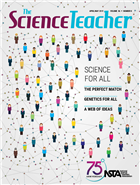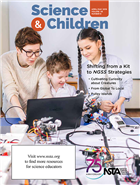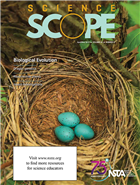Ideas and inspiration from NSTA’s April 2019 K-12 journals
By Mary Bigelow
Posted on 2019-04-12
Regardless of what grade level or subject you teach, check out all three K-12 journals. As you skim through titles and descriptions of the articles, you may find ideas for lessons that would be interesting for your students, the inspiration to adapt a lesson to your grade level or subject, or the challenge to create/share your own lessons and ideas. Click on the links to read or add to your library.
The lessons described in the articles include a chart showing connections with the NGSS. The graphics are especially helpful in understanding the activities and in providing ideas for your own investigations.
NSTA members have access to the articles in all journals, including the Journal of College Science Teaching.
 The Science Teacher – Science for All
The Science Teacher – Science for All
Every year TST has an issue with this theme. Even if you teach elementary or middle school, you can find ideas and strategies that could be adapted to your students.
Editor’s Corner: Science For All – “Whether your interest is in diversity education, multicultural awareness, equity and inclusion issues, teaching English learners, or simply finding engaging teaching methods for all students, I encourage you to browse the TST online archive, where a simple keyword search will bring up a wealth of timeless articles and still-relevant activities on the ‘Science for All’ theme.”
Many authors share resources related to the lessons and strategies in their articles. These resources include rubrics, graphic organizers, handouts, diagrams, lists of resources, and complete lessons. You can access these through the Connections link for The Science Teacher.
- Although many teachers have heard of and use Exit Tickets, their use could be even more effective. This article takes a closer look at this strategy, with examples, prompts, and action research results on how teachers can analyze the content and patterns of the student responses as formative assessment.
- Using geospatial technologies while Investigating Urban Trees, students explore their school’s surroundings, identify trees, assess their environmental and social benefits, and investigate relationships between the location of trees and crime reports. The article showcases maps and charts and has suggestions and resources for similar projects.
- Take a plant study unit to a new level by finding The Perfect Match between flowering plants and their pollinators.
- Looking for a way to introduce genetics? Genetics for All describes a variety of activities, organized as learning stations, that focus on the topic. “With increasing class sizes, we recognize that station work acts as an additional support to students by allowing each student to have closer interactions with their teacher.”
- A Web of Ideas is not about arachnids! The article introduces a scaffolding strategy to promote higher-level discourse in the classroom for students who may not understand how to have productive discussions. The article includes examples of questions, organizing strategies, student roles, and photos of students in action.
These monthly columns continue to provide background knowledge and classroom ideas:
- Focus on Physics: Refraction
- Career of the Month: Ecologist
- Right to the Source: Science for All—19th Century “Edutainment” describes traveling science “shows” that were meant to inform and educate 19th century audiences.
For more on the content that provides a context for projects and strategies described in this issue, see the SciLinks topics Alexander Graham Bell, Cells, Chromosomes, Cloning, Coevolution, Communication Technology, Dichotomous Keys, Ecology, Ecosystems, Electrophoresis, Genetics, Inventors, Organelle, Pollination, Refraction, Telephone Technology, Transcription, Translation
Continue for Science and Children and Science Scope.
 Science & Children – Shifting from a Kit to NGSS Strategies
Science & Children – Shifting from a Kit to NGSS Strategies
Whether you’re an elementary teacher with an inventory of science kits or a secondary teacher with cookbook labs, these suggestions can help you adapt and update these lessons to incorporate NGSS disciplinary core ideas, crosscutting concepts, and science/engineering practices.
Editor’s Note: Shifting From Kits to NGSS Strategies: “The reality is that even the most exquisitely designed kit will fall short unless the teacher has time to immerse themselves in the pedagogy and understands the rationale for following prescribed steps. …As you implement some of the lessons and strategies in this month’s issue of Science and Children [and other journals], think about how we can continue to move from the cookbook recipe approach to designing wholesome, fully balanced learning situations.”
Many authors share resources related to the lessons and strategies in their articles. These resources include rubrics, graphic organizers, handouts, diagrams, lists of resources, and complete lessons. You can access these through the Connections link for Science & Children.
- According to the author of The Early Years: Creating a Kit, “Kits make it easy for multiple teachers to teach the same lesson by having access without duplicating all materials, especially those that may be unique to a particular activity such as a spring scale or a set of igneous rocks. …The most useful kits are often those put together by you or another educator to meet updated standards or the specific needs of your program.” The article includes a how-to discussion on creating a kit to explore the properties of water.
- Pulley Islands describes how to repurpose of kit on simple machines into an adventure in tinkering, which “encourages the use of authentic, hands-on experience to develop an understanding of content and physical materials” and explore problem solving with the concepts of force and motion.
- Tinkering and problem solving are also the focus in From Global To Local, describing a summer enrichment program in which students explored mag-lev technology.
- It’s Alive?!? poses a question for young students on determining the characteristics of living things by looking for patterns and creating a “checklist.”
- The Worms Are Dancing! was the observation in a class of kindergarten students during this integrate unit as they studied live earthworms.
- Cultivating Curiosity About Creatures includes photos of students’ work as they study the adaptations and behaviors of crayfish (although I suspect other available animals could be substituted in the lesson.)
- Formative Assessment Probes: Our Best Thinking So Far includes the probe Can a Plant Break Rocks? The article also describes the structure of a probe and a rationale for using them to connect the three components of the NGSS.
- Teaching Through Trade Books: The Dynamics Within Ecosystems includes two lessons (Growing Plants K-2 and An Owl’s Lunch 3-5) that take traditional lessons on planting seeds and dissecting owl pellets to a higher-level exploration of the concept of ecosystems. The K-2 lesson has a table focusing on variables that could be helpful to any grade level.
- The lesson in Methods & Strategies: Getting a Grip also focuses on systems that include plants. The authors includes an “Investigations Framework” for “rethinking the classroom investigation” to encourage students in argumentation, explanation, and investigating.
- Students design and create robotic animals, as part of the makerspace in Engineering Encounters: Animatronic Lions, and Tigers, and Bears Oh! My!
These monthly columns continue to provide background knowledge and classroom ideas:
- The Poetry of Science: Science Strategies Through Poetry (Sink or Float)
- Science 101: If a tree falls in a forest, and there’s no one around to hear it, does it make a sound?
- Teaching Teachers: STEM and Community Engagement summarizes an “opportunity for pre-service teachers to create an authentic learning experience for students and their families that expanded content beyond the walls of the classroom.”
For more on the content that provides a context for projects and strategies described in this issue, see the SciLinks topics Adaptations of Animals, Arthropods, Buoyancy, Characteristics of Living Things, Ecosystems, Erosion, Forces and Motion, Inventions, Magnetic Fields, Pitch, Robots, Simple Machines, Sound, Water Cycle, Worms
 Science Scope – Biological Evolution
Science Scope – Biological Evolution
From the Editor’s Desk The Necessity of Teaching Evolution – “Teachers can help students develop scientific habits of mind by requiring them to ask questions and practice separating fact from fiction. This skill is at the heart of being able to think scientifically, particularly when it comes to understanding abstract theories such as evolution…. Only by teaching students to think like scientists will Darwin’s theory become better understood.”
Articles in this issue that describe lessons (many of which use the 5E model) include a helpful sidebar documenting the big idea, essential pre-knowledge, time, safety issues, and cost. The lessons also include connections with the NGSS.
Many authors share resources related to the lessons and strategies in their articles. These resources include rubrics, graphic organizers, handouts, diagrams, lists of resources, and complete lessons. You can access these through the Connections link for Science Scope.
- The authors of Making Critical Thinking Visible for Student Analysis and Reflection provide links to the resources and a detailed description of the process designed to support critical thinking, analysis, and reflection. Students applied the process using the question “What dinosaur did these bones come from?”
- Sharing the Wonder of Natural History has several suggestions for overcoming “nature-deficit disorder,” including nature journaling (template provided), creating local field guides, focused scavenger hunts, and studying the work of nature artists (with suggestions).
- You probably already have the materials for Science on a Shoestring: Using Insect Biodiversity to Build Basic Skills. This activity is deceptively simple, but students can plan investigations, collect and analyze data, interpret and graph their results, and communicate their results.
- Integrating Technology: Genetics with Dragons describes a digital genetics game (free-link is provided) in which students explore the connections between genes, cells, proteins, traits, and inheritance patterns.
- Teacher’s Toolkit: Jumping to Conclusions elaborates a “jump and reach” activity into a lesson on predictive modeling in which they apply measurements, basic statistics, and graphing.
- Citizen Science: Squirrel Mapper demonstrates that what goes on outside the window is not necessarily a distraction, but could be an integral part of the learning and investigating processes. Students investigate variations in squirrel colorations.
- Commentary: Using Critical Thinking Skills to Counter Misinformation “Teachers should teach students how to investigate suspicious ‘scientific’ claims they encounter in media. In general, students should be taught to think critically using Purpose, Author, Relevance, Currency, and Sources (PARCS).” The article describes these criteria.
- “To help develop students’ writing skills, we need to provide them with opportunities to write often. For students who may struggle with writing, we can scaffold writing with talk, showcase positive writing models, and use graphic organizers and writing frames.” Science for All: Evolving Students’ Writing Skills has suggestions for developing writing skills in science.
- Teacher to Teacher: Speaking and Listening in the Classroom has ideas for incorporating two components of literacy that are often overlooked. Students may need guidance on presenting and listing critically to others
These monthly columns continue to provide background knowledge and classroom ideas:
- Scope on the Skies: Observing Environmental Changes from Earth’s Orbit
- Interdisciplinary Ideas: Data Literacy 101 has a step-by-step strategy for help students connect data to explanations in a claims-evidence-reasoning framework.
- Disequilibrium: Investigating the Resurrection Plant
For more on the content that provides a context for projects and strategies described in this issue, see the SciLinks topics Adaptation of Plants, Animal Adaptations, Biodiversity, Biological Evolution, Climate, Deserts, Dichotomous Keys, Dinosaurs, Dominant and Recessive Traits, Fossils, Genetics, Insects, Migration, Satellite Technology, Vertebrate Evolution, Wetlands
Disclaimer: The views expressed in this blog post are those of the author(s) and do not necessarily reflect the official position of the National Science Teaching Association (NSTA).


